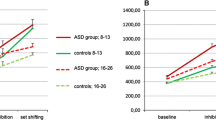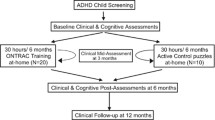Abstract
The present study examines the hypothesis that motor responses added into rote tasks would modulate the sensation-seeking activity and impulsive errors of hyperactive (ADD-H) children. To this purpose 22 ADD-H and 25 comparison children were administered two repetitive tasks (word decoding and an auditory vigilance task) under both an active response and a passive response condition. Findings were that the impulsive errors, talking/noise-making, and activity of ADD-H children was normalized (i.e., did not differ from comparison children) only in the high stimulation active response conditions. Behavioral improvements for ADD-H children were documented in both tasks in the active condition, but performance gains were found only in the vigilance task. The findings supported predictions derived from the optimal stimulation theory that the excessive activity and attraction to novel stimuli of ADD-H children can be channeled into appropriate instrumental motor and attention responses.
Similar content being viewed by others
References
Allred, R. A., Baird, L. O., & Read, E. A. (1984).Keys to spelling mastery. Oklahoma City, Oklahoma: The Economy Company.
Conners, C. K. (1973), Rating scales for use in drug studies with childrenPsychopharmacology Bulletin (Special Issue),9, 24–84.
Douglas, V. I., & Peters, K. G. (1979). Toward a clearer definition of the attentional deficit of hyperactive children. In G. A. Hale & M. Lewis (Eds.),Attention and the development of cogitive skills (pp. 173–247). New York: Plenum Press.
Eaton, W. (1983). Measuring activity level with actometers: Reliability, validity, and arm length.Child Development, 54, 720–726.
Kahneman, D. (1973).Attention and effort. Englewood Cliffs, New Jersey: Prentice-Hall.
Leuba, C. (1955). Toward some integration of learning theories: The concept of optimal stimulation.Psychological Reports, 1, 27–33.
Madan-Swain, A. J., & Zentall, S. S. (1987).Behavioral comparisons of accepted and rejected hyperactive children and their matched controls in play settings. Manuscript submitted for publication.
Pelham, W. E., & Bender, M. E. (1982). Peer relationships in hyperactive children: Description and treatment.Advances in Learning and Behavioral Disabilities, 1, 365–436.
Quay, H. C. (1979). Classification. In H. C. Quay & J. S. Werry (Eds.),Psychopathological disorders of children (2nd ed., pp. 1–42). New York: Wiley.
Rosenthal, R. H., & Allen, T. W. (1980). Intratask distractibility in hyperkinetic and nonhyperkinetic children.Journal of Abnormal Child Psychology, 8, 175–187.
Sykes, D. H., Douglas, V. I., & Morgenstern, S. (1972). Sustained attention in hyperactive children.Journal of Child Psychology and Psychiatry, 14, 213–220.
Ullman, R. K., Sleator, E. K., & Sprague, R. L. (1985). Change of mind: The Conners Abbreviated Rating Scales reconsidered.Journal of Abnormal Child Psychology, 13, 553–565.
Zentall, S. (1975). Optimal stimulation as theoretical basis of hyperactivity.American Journal of Orthopsychiatry, 45, 549–563.
Zentall, S. S. (1985). Stimulus-control factors in search performance of hyperactive children.Journal of Learning Disabilities, 18, 480–485.
Zentall, S. S. (1986). Effects of color stimulation on performance and activity of hyperactive and nonhyperactive children.Journal of Educational Psychology, 78, 159–165.
Zentall, S. S., & Barrack, R. S. (1979). Rating scales for hyperactivity: Concurrent validity, and decision to label for the Conners and Davids abbreviated scales.Journal of Abnormal Child Psychology, 7, 179–190.
Zentall, S. S., Falkenberg, S. D., & Smith, L. B. (1985). Effects of color stimulation on the copying performance of attention-problem adolescents.Journal of Abnormal Child Psychology, 13, 501–511.
Zentall, S. S., Gohs, D. E., & Culatta, B. (1983). Language and activity of hyperactive and comparison preschoolers in a listening task.Exceptional Children, 50, 255–266.
Zentall, S. S., & Kruczek, T. (in press). The attraction of color for active attention problem children.Exceptional Children.
Zentall, S. S., & Shaw, J. H. (1980). Effects of classroom noise on performance and activity of second-grade hyperactive and control children.Journal of Educational Psychology, 72, 830–840.
Zentall, S. S., & Zentall, T. R. (1976). Activity and task performance of hyperactive children as a function of environmental stimulation.Journal of Consulting and Clinical Psychology, 44, 693–697.
Zentall, S. S., & Zentall, T. R. (1983). Optimal stimulation: A model of disordered activity and performance in normal and deviant children.Psychological Bulletin, 94, 446–471.
Zentall, S. S., Zentall, T. R., & Barack, R. C. (1978). Distraction as a function of within-task stimulation for hyperactive and normal children.Journal of Learning Disabilities, 11, 540–548.
Zentall, S. S., Zentall, T. R., Booth, M. E. (1978). Within-task stimulation: Effects on activity and spelling performance in hyperactive and normal children.Journal of Educational Research, 71, 223–230.
Author information
Authors and Affiliations
Additional information
We thank Anne Dwyer for her help with data collection, and Phyllis Kikendall, Sylvia Kottler, Joe Boggs, and Cheryl Wieczorek for their assistance at various stages of this project. We are also most grateful to Martha Eger and to the teachers, Sally Schnieder and Denise Oliver, of West Central Joint Special Services, to Pat Welch of the Catholic Social Services, and to the teachers of St. Ann's School and St. Philip Neri School for their cooperation with this research.
Rights and permissions
About this article
Cite this article
Zentall, S.S., Meyer, M.J. Self-regulation of stimulation for ADD-H children during reading and vigilance task performance. J Abnorm Child Psychol 15, 519–536 (1987). https://doi.org/10.1007/BF00917238
Revised:
Issue Date:
DOI: https://doi.org/10.1007/BF00917238




